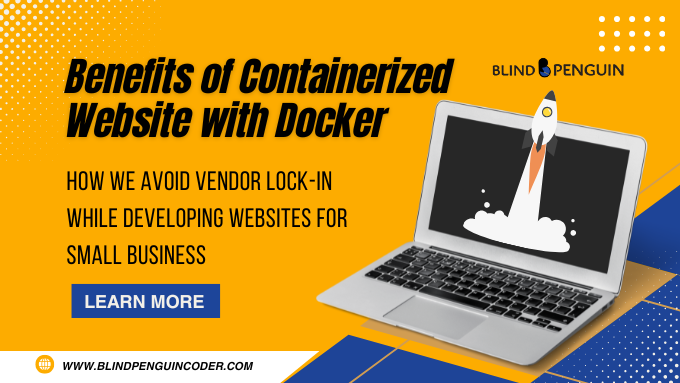A few months ago, I met Pablo Gilbes, an entrepreneur starting his own business. You might remember him and his company, RG Seamer Service, from this article. He approached BlindPenguin with a clear vision: a modern, high-performance website to establish his online presence. WordPress was an obvious choice for its user-friendly content management, and it’s a perfect tool for website development for small businesses. However, we knew that a standard, shared-hosting setup would limit flexibility and risk vendor lock-in. Instead, we embraced open-source tooling and containerization to give Pablo the autonomy he needed without sacrificing reliability or scalability.

Choosing the Right Website Infrastructure for Your Small Business
To bring RG Seamer Service online, we began by provisioning an Ubuntu 24.04 LTS server on Linode. Using Docker Compose, we containerized each core service (PHP-FPM, Nginx, and MariaDB) into its own isolated environment. This approach guarantees that every component runs with exactly the dependencies it requires, simplifies future upgrades, and keeps the entire stack portable. We automated HTTPS through Let’s Encrypt and Certbot, ensuring SSL certificates are issued and renewed without manual intervention. All persistent data is stored on Docker volumes. This protects uploads, databases, and certificates during updates or restarts.
But website development for small businesses is more than just its front end. For email, we integrated Google Workspace on the client’s custom domain. We directed MX records to Google’s infrastructure. This gives Pablo enterprise-grade email, calendars, and tools—aligned with our open-platform philosophy. The result is a cohesive ecosystem: containerized web services, open-source SSL, and cloud-hosted email, all designed for performance, security, and full client ownership.
How to Avoid Vendor Lock-In in Website Development for Small Businesses
At first glance, our stack might seem simple, a classic LAMP-style setup running in Docker, but simplicity can be powerful. Small businesses often face a tough choice. Either subscribe to feature-packed SaaS platforms they’ll never fully use, or overspend on custom development. Having worn both hats—as a small-business owner and as an engineer at high-end firms—I’ve learned that the ideal solution strikes a balance between cost, capability, and control. By leveraging proven, open-source technologies and modern DevOps practices, we delivered a site that’s both affordable and future-proof.
RG Seamer Service’s poject reaffirmed a core principle at BlindPenguin: the best solution for website development for small businesses isn’t always the flashiest one. It’s the one that aligns with a client’s needs, budget, and long-term goals. We need to deliver an easy-to-manage, high-performing site free from vendor lock-in. That’s why we user WordPress stack on Ubuntu 24.04 LTS, automated SSL with Let’s Encrypt, and Google Workspace.

Start Smart: Website Development for Small Businesses That Need Scalability and Control
If you’re a small-business owner weighing the trade-offs between off-the-shelf subscriptions and custom builds, consider a lean, containerized approach. It’s an investment in both reliability and autonomy. Just like RG Seamer Service, you’ll be ready to hit the ground running.
RG Seamer Service’s website shows that a straightforward, containerized LAMP stack can deliver exactly what small businesses need: performance, security, and complete ownership. With Docker Compose on Ubuntu 24.04 LTS in Linode, automated SSL via Let’s Encrypt, and Google Workspace for email. Pablo manages both content and infrastructure with ease—no hidden fees or restrictive contracts required.
At BlindPenguin, we match the right technology to each client’s real needs, leveraging open-source tools to maximize flexibility and minimize costs.



